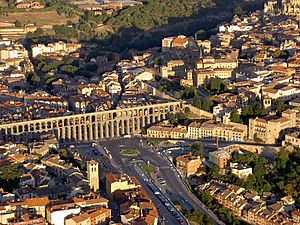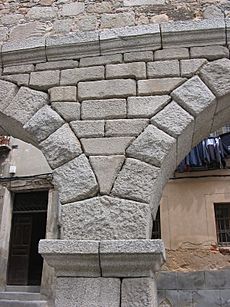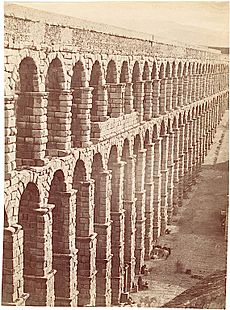Aqueduct of Segovia facts for kids
|
Acueducto de Segovia
|
|

Aqueduct bridge over plaza del Azoguejo
|
|
| Location | Segovia, Spain |
|---|---|
| Type | Roman aqueduct |
| History | |
| Material | Granite |
| Official name: Aqueduct of Segovia | |
| Type: | Cultural |
| Criteria: | i, iii, iv |
| Designated: | 1985 (9th session) |
| Part of: | Old Town of Segovia and its Aqueduct |
| Reference #: | 311 |
| Region: | Europe and North America |
| Official name: Aqueduct | |
| Type: | Non-movable |
| Criteria: | Monument |
| Designated: | 11 October 1884 |
| Reference #: | RI-51-0000043 |
The Aqueduct of Segovia (Spanish: Acueducto de Segovia) is an amazing Roman aqueduct in Segovia, Spain. It was built about 2,000 years ago. Its job was to bring fresh water from mountain springs, about 17 kilometers (10.5 miles) away, into the city.
This water filled public fountains, baths, and even private homes. People used it all the way until 1973! The tall part of the aqueduct, with its 167 arches, is one of the best-preserved Roman aqueduct bridges. It's a huge symbol of Segovia. You can even see it on the city's official coat of arms. In 1985, the Old Town of Segovia and its aqueduct became a UNESCO World Heritage Site.
Contents
History of the Aqueduct
The exact date the aqueduct was built was a mystery for a long time. This is because the original inscription (a carved message) on its top part is now missing. Experts thought it was built in the 1st century AD. This was during the time of Roman Emperors like Domitian, Nerva, and Trajan.
Later, a smart person named Géza Alföldy figured out the missing text. He looked at the holes where bronze letters used to be. He found out that Emperor Domitian (who ruled from 81–96 AD) ordered it to be built. The year 98 AD was thought to be when it was finished.
However, new discoveries in 2016 suggest it might be a bit newer. It could have been built after 112 AD, during Emperor Trajan's rule, or early in Emperor Hadrian's rule (starting 117 AD).
We don't know exactly when Segovia itself began. We do know that the Arevaci people lived there before the Romans took over. Roman soldiers then settled in the area. Segovia was part of a Roman region ruled from a place called Clunia.
How the Aqueduct Works
The aqueduct brought water from the Rio Frio river. This river is in the mountains about 17 kilometers (10.5 miles) from Segovia. The water travels about 15 kilometers (9.3 miles) before it even reaches the city.
The way the aqueduct was built follows ideas from an ancient Roman writer named Vitruvius. He wrote a famous book about architecture in the 1st century BC.
Water Collection and Cleaning
First, the water was collected in a large tank called El Caserón (which means "Big House"). From there, it flowed through a channel to a second tower called the Casa de Aguas ("Waterhouse"). Here, the water was naturally cleaned. Sand and dirt would settle to the bottom. This made the water clearer before it continued its journey.
After the Waterhouse, the water traveled 728 meters (796 yards) downhill. It had a gentle slope of one percent. This allowed the water to flow high up to the Postigo. This is a rocky area where the walled city center and its castle sit.
The Aqueduct Bridge
To get the water into the old city, it crosses a huge aqueduct bridge. At a place called Plaza de Díaz Sanz, the structure turns sharply. Then it heads towards Plaza Azoguejo. This is where the aqueduct really shows off its amazing size.
At its highest point, the aqueduct reaches 28.5 meters (93.5 feet) tall. This includes almost 6 meters (19.7 feet) of its deep foundation. The aqueduct has both single and double arches. These arches are held up by strong pillars.
From where it enters the city to Plaza de Díaz Sanz, the aqueduct has 75 single arches and 44 double arches. If you count each arch in the double sections, that's 88 arches. Then there are four more single arches. This makes a total of 167 arches!
The first part of the aqueduct has 36 half-circle arches. These were rebuilt in the 15th century. They had been destroyed by the Moors in 1072. The arches are arranged in two levels. They have simple decorations. The top arches are 5.1 meters (16.1 feet) wide. The pillars on the top level are shorter and narrower than the ones below.
At the very top of the structure is the channel where the water flows. It's shaped like a "U" and is about 0.55 meters (1.8 feet) tall and 0.46 meters (1.5 feet) wide. The top of each pillar is about 1.8 by 2.5 meters (5.9 by 8.2 feet) wide. The bottom of each pillar is larger, about 2.4 by 3 meters (7.9 by 9.8 feet) wide.
The aqueduct is built from unmortared granite blocks. This means no cement was used to hold the stones together! During Roman times, the three tallest arches had signs with bronze letters. These signs told who built it and when.
Today, you can still see two niches (small carved-out spaces) on the aqueduct. One of them used to hold a statue of Hercules. Legend says Hercules founded the city. Now, that niche holds a statue of the Virgin Mary. The other niche once held a statue of Saint Stephen, but it is now gone.
Water Distribution in the City
Inside the walled city, there was a system to spread the water. This was done through a main water tank called a castellum aquae. We don't know all the details of this system. But we do know that the water flowed underground. You can even see where the main channel was marked on the city's sidewalks.
Later History and Care
The first time the aqueduct was rebuilt was during the rule of King Ferdinand and Queen Isabella. They were known as the Catholic Monarchs. A monk named Don Pedro Mesa from a nearby monastery led this project. They rebuilt 36 arches. They were very careful to keep the original look and style.
Later, in the 16th century, the statues were placed in the niches on the aqueduct. Every year on December 4th, which is the day of Saint Barbara (the patron saint of artillery), students from the local military academy drape the statue of the Virgin de la Fuencisla with a flag.
The aqueduct is the most important building in Segovia. It has been used for centuries and is still in great shape. It provided water to Segovia until the mid-19th century.
However, over time, some stone blocks started to wear down differently. Water leaked from the top channel. Also, pollution caused the granite ashlar masonry (the way the stones are put together) to get worse and crack. Because of these issues, the aqueduct was put on the 2006 World Monuments Watch list by the World Monuments Fund (WMF).
Many people thought that the shaking from cars passing under the arches damaged the aqueduct. But this was not true because the aqueduct is so massive. WMF Spain worked with the Ministry of Culture, the government of Castilla y León, and other local groups. They all helped to fix and protect the aqueduct.
See also
 In Spanish: Acueducto de Segovia para niños
In Spanish: Acueducto de Segovia para niños
- List of aqueducts in the Roman Empire
- List of Roman aqueducts by date
- Ancient Roman technology
- Roman engineering






